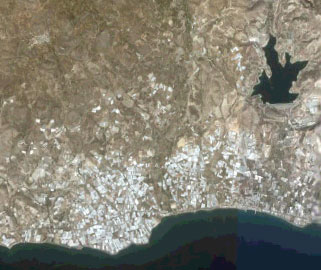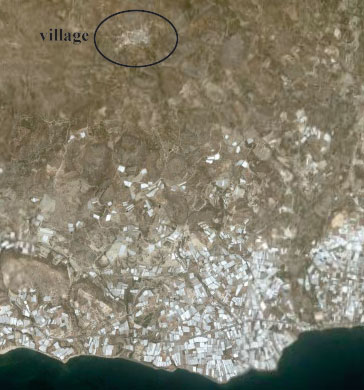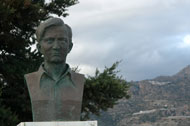Greenhouses: history, prospects, issues.
The first greenhouse was constructed in 1965?? by Pavlos Cooper (1930-1971), a Dutch agricultural engineer, who came to the area and immediately recognized its potential due to three main factors: (1) the emerging market for out of season vegetables (tomatoes in the winter) fueled by the expanding middle classes across Europe, (2) the excellent climate of the region that is conducive for the cultivation of climate sensitive products and (3) the deep knowledge of the local people with years of agricultural experience.
|
|
Even-though the economic benefits that are derived from the agricultural (greenhouse) character of the region have been undeniably positive, the one dimensional character of the economy has started to present various challenges to the economic, social and environmental foundation of the entire region. The economic advantages derived directly from the climatic character of the area have become marginal. Extensive competition has constrained the pricing structure of the vegetable market while at the same time the production cost per unit of product has been climbing at an unsustainable and unjustifiable rate. The labor intensity of the greenhouse industry, and the availability of low cost labor, offered by legal and illegal economic migrants, fueled a further expansion of the industry at the moment when sound investment and the opening of new markets should have been the focus. The relatively positive labor cost offered by migrant workers resulted in a status quo of the industry with a focus on increasing production volume with minimal and inconsequential effort placed on the opening of new markets and expansion of the product range. The limited land available for greenhouse construction in the lower flat regions has forced the placement of new greenhouses in areas of higher elevation, requiring extensive land preparation thereby permanently scaring the landscape and placing untenable demands on the regions limited water resources. The area close to the sea with the high density of greenhouses is called xerokambos (ξερόκαμπος) (dry plane). It was until the beginning of the 70s indeed a dry plane. The cultivation of vegetables (tomatoes, zucchini etc) was done in this area prior to the arrival of greenouses. This activity started slowly after the end of the second world war with marginal economic benefits, constrained by the lack of water and the high probability of loosing the exposed crop to high winds, hail and the occasional, albeit infrequenct, frost. The fileds close to the sea, where most of the greenhouses are now located, were safer from frost but were susceptible to the very distructing salt spray from the sea during the frequent and violent southern storms. |
|
 With the advent of greenhouses, the piping of water from wells collected in a number of cisterns provided the water needed for sustaining greenhouse crops. As the number of greenhouses increased the demand for water exceeded the supply of the wells that were drilled even as far as 10 km away. The problem was addressed by the construction of an artificial lake in the location of bramiana (μπραμιανά) as sown on the satellite image to the left. The lake is supplied by rain water and by a pipeline bringing water from the river of Myrtos , 20 km away. Recently another pipeline brings water, albeit of lower quality, into the lake from a spring at Malavra (Mαλαύρα) at the north coast of the island close to Kavousi 40 km away. With the advent of greenhouses, the piping of water from wells collected in a number of cisterns provided the water needed for sustaining greenhouse crops. As the number of greenhouses increased the demand for water exceeded the supply of the wells that were drilled even as far as 10 km away. The problem was addressed by the construction of an artificial lake in the location of bramiana (μπραμιανά) as sown on the satellite image to the left. The lake is supplied by rain water and by a pipeline bringing water from the river of Myrtos , 20 km away. Recently another pipeline brings water, albeit of lower quality, into the lake from a spring at Malavra (Mαλαύρα) at the north coast of the island close to Kavousi 40 km away. |
|
Compared to other intense agricultural regions, the quality of the produce coming out of this region has been superior primarily due to the climate and the water quality. The water used for the irrigation of the greenhouses is pure and thus it does not introduce any of the issues associated with contaminated water acquifers. However, the agricultural runoff has had a devastating effect on the sea life. The extensive use of fertilizers and pesticides in the greenhouses find their way in the sea due to the geologic character of the area. Hypertrophy is thus evident all along the coast line. Is the greenhouse based economy the only way to proceed? |
|
 The landscape of Anatoli is directly and indirectly dominated by the agricultural greenhouse industry. On the picture to the right you see an aerial image of the area. The white regions correspond to greenhouses. Most of the greenhouses are concentrated close to the sea, where the land is flat. As you can also see there is a number of greenhouses at higher elevations halfway between the seashore and the village.
The landscape of Anatoli is directly and indirectly dominated by the agricultural greenhouse industry. On the picture to the right you see an aerial image of the area. The white regions correspond to greenhouses. Most of the greenhouses are concentrated close to the sea, where the land is flat. As you can also see there is a number of greenhouses at higher elevations halfway between the seashore and the village.  As a tribute to his vision and contribution to the region a statue of Mr. Cooper is located at the entrance of Stomio Anatolis.
As a tribute to his vision and contribution to the region a statue of Mr. Cooper is located at the entrance of Stomio Anatolis.